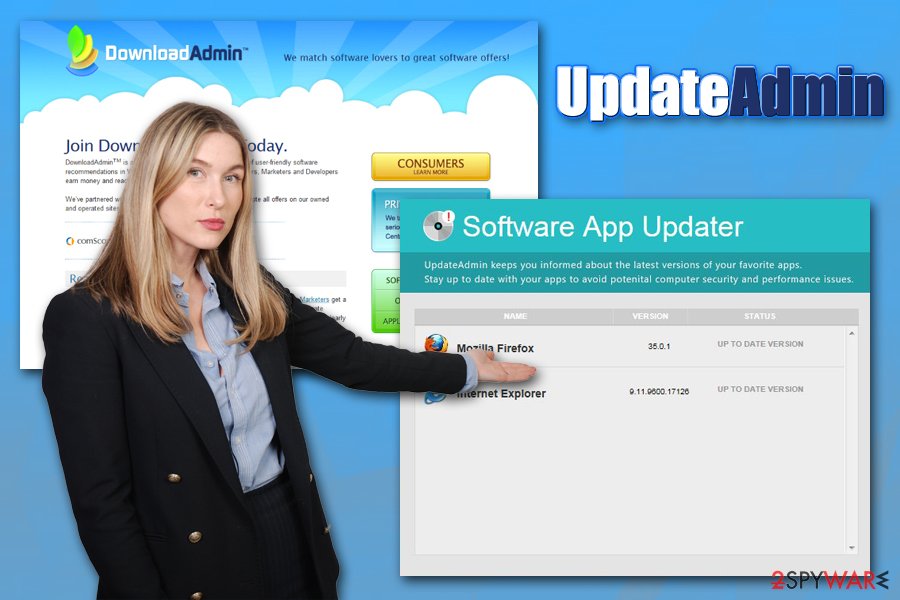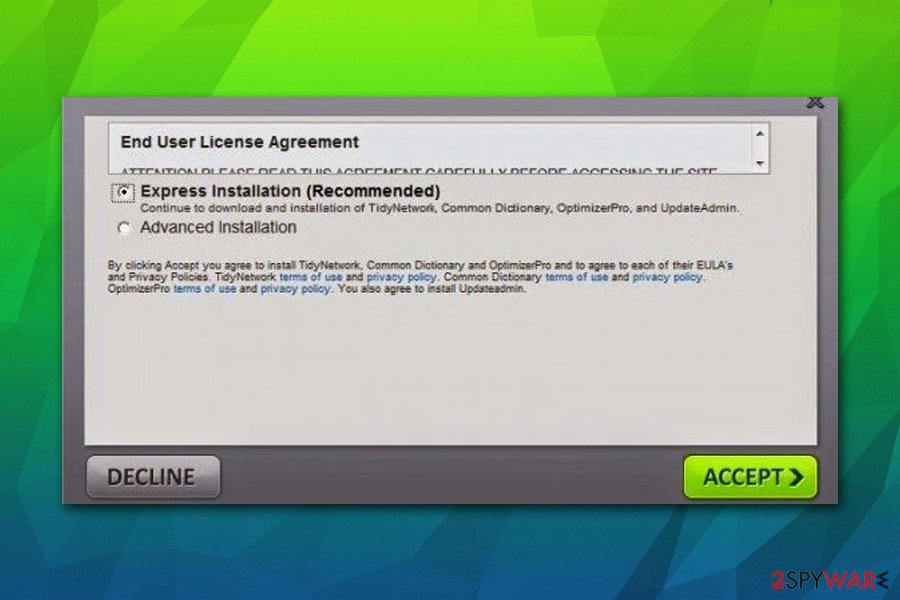UpdateAdmin adware (Removal Instructions) - Jan 2020 update
UpdateAdmin adware Removal Guide
What is UpdateAdmin adware?
UpdateAdmin is a potentially unwanted program that is recognized by multiple AV providers

UpdateAdmin, also known as DownloadAdmin by Tightrope Interactive, is an application that is allegedly designed to help users easily download and install new programs, as well as update the existing ones. While the functionality of this download manager might seem useful for some, it is also worth mentioning that it is an adware app that will spam your Google Chrome, Safari, Mozilla Firefox, or Internet Explorer with intrusive ads. Additionally, if you decide to use UpdateAdmin for downloading apps, you should be aware that you might end up installing malware even without realizing it.
In most cases, users do not download UpdateAdmin intentionally, as it is often bundled with other software that hosted on third-party sites. Due to careless installation practices of users and clever placements of optional components within the installers of app developers, the potentially unwanted program often managed to sneak in unnoticed. As a result, users may find their web browser settings altered, and pop-ups, deals, offers, flashing windows will start interfering with their web browser sessions as long as UpdateAdmin remains on the system.
| Name | UpdateAdmin |
| Also known as | DownloadAdmin, Bush Street Installer |
| Developer | Tightrope Interactive |
| Type | Adware, potentially unwanted program |
| Related files | UpdateAdmin.exe, UpdateAdmin-bg.exe, UpdateAdmin-bho64.dll, UpdateAdmin-nova.exe |
| Infiltration | PUPs are typically installed together with freeware/shareware apps acquired from third-party websites |
| Risks | Users might be redirected to scam and phishing sites where they will be asked to install other potentially unwanted programs to allegedly remove viruses from the computer or to provide their personal information |
| Symptoms |
|
| Termination | Scan your machine with anti-malware software or check out our manual removal guide below |
| Recovery | If your computer shows unwanted signs after the infection is terminated, such as slowness, errors, BSODs, and similar, you can repair system files with FortectIntego |
The main functionality of UpdateAdmin is that it would let users keep all the applications updated, which may seem like a nice feature. However, most of the apps update automatically as long as settings are configured correctly. Nevertheless, it is indeed important to keep all apps on the system patched, as software vulnerabilities are serious security hazard – it allows malicious actors to insert malware automatically. UpdateAdmin is not a good option when trying to protect yourself from these attacks, however.
Despite its functionality, UpdateAdmin will display intrusive pop-ups and another type of commercial content during web browsing sessions, which may seem annoying, as they cover the original content of the website and slow down its loading speed. In most cases, UpdateAdmin ads will not be marked, although users might sometimes see the following tags:
- Ads by UpdateAdmin
- UpdateAdmin ads
- Brought to you by UpdateAdmin
- Powered by UpdateAdmin, etc.
UpdateAdmin ads, in some cases, might lead users to not so secure sites, including phishing, scam, and even ones that hold malicious background scripts. As a result, users might be prompted to install potentially unwanted programs to allegedly get rid of viruses or provide personal information, as well as enter their credentials into a spoofed site. Due to this, the “UpdateAdmin virus” term is quite acceptable, although not entirely correct technically.
Another reason to remove UpdateAdmin is its information tracking practices – the application functions as adware, so its main monetization method is by showing users ads whenever they browse the web. However, to do that more effectively, PUP developers often collect a variety of information about users – especially when it comes to their web browsing habits.

Harvesting of data is often performed with the help of cookies or other tracking technologies,[1] which can collect information about users' visited websites, links clicked, ads interacted with, sites visited, as well as the ISP, IP address, and other technical information. Some adware is also capable of collecting personal information, so it is advisable to read the Privacy Policy of all apps that are installed on the system.
UpdateAdmin removal can be accomplished relatively easily with the help of anti-malware software that can recognize the PUP. Nevertheless, it should not be difficult to get rid of the app manually as per the instructions below. Nevertheless, for best results, experts[2] recommend resetting all the installed browsers and performing a scan with FortectIntego to ensure the machine would not crash or return errors later.
PUPs land on users' machines unnoticed due to software bundling practices
Many potentially unwanted programs employ an official website where the main installer resides. Nevertheless, they are frequently promoted via other freeware as an “optional install.” Such distribution method is legitimate; however, it's very deceptive and can lead to the unconscious installation of various PUPs.
In order to prevent the unsolicited installation of adware, including Youtube Accelerator, BetterMarkit, and others, you should verify the reliability of every freeware by carefully reading installation instructions, as many tricks are used to hide optional components during the process.
Besides, be very careful when downloading programs from popular download sources, such as download.com, soft32.com, softonic.com, cnet.com, etc., because they tend to promote software packages. If possible, always choose to download software from official sources such as Microsoft Store, App Store, and others – these stores have a collection of millions of apps with various functionality, so there is plenty to choose from.
It is also worth noting that websites that host illegal software installers and software cracks are dangerous – the bundling can go much further and result in the installation of not only PUPs but also malware. Therefore, avoid torrent, warez, crack, and similar sites.

Get rid of UpdateAdmin
Adware might be not only annoying but also dangerous. Therefore, it is best to remove UpdateAdmin and similar ad-supported software and instead choose reputable alternatives. Note that much of the functionality of this application can be replaced manually – simply set up all the apps to be updated automatically of use the “Check for updates” feature.
You can achieve an easy UpdateAdmin removal with the help of anti-malware software with the “detect potentially unwanted programs” feature on. Keep in mind that having a powerful security program is mandatory for keeping your machine safe from trojans, viruses, worms, rootkits,[3] ransomware, and other malware.
Alternatively, you can get rid of UpdateAdmin with the help of our instructions below – follow each step carefully. Beware that the application changes your web browser settings, and unless you reset them, the unwanted advertisements will continue to show up, even after the termination of the app.
You may remove virus damage with a help of FortectIntego. SpyHunter 5Combo Cleaner and Malwarebytes are recommended to detect potentially unwanted programs and viruses with all their files and registry entries that are related to them.
Getting rid of UpdateAdmin adware. Follow these steps
Uninstall from Windows
To terminate UpdateAdmin from Windows, follow these steps:
Instructions for Windows 10/8 machines:
- Enter Control Panel into Windows search box and hit Enter or click on the search result.
- Under Programs, select Uninstall a program.

- From the list, find the entry of the suspicious program.
- Right-click on the application and select Uninstall.
- If User Account Control shows up, click Yes.
- Wait till uninstallation process is complete and click OK.

If you are Windows 7/XP user, proceed with the following instructions:
- Click on Windows Start > Control Panel located on the right pane (if you are Windows XP user, click on Add/Remove Programs).
- In Control Panel, select Programs > Uninstall a program.

- Pick the unwanted application by clicking on it once.
- At the top, click Uninstall/Change.
- In the confirmation prompt, pick Yes.
- Click OK once the removal process is finished.
Delete from macOS
macOS users should perform the following steps to get rid of adware and other unwanted apps:
Remove items from Applications folder:
- From the menu bar, select Go > Applications.
- In the Applications folder, look for all related entries.
- Click on the app and drag it to Trash (or right-click and pick Move to Trash)

To fully remove an unwanted app, you need to access Application Support, LaunchAgents, and LaunchDaemons folders and delete relevant files:
- Select Go > Go to Folder.
- Enter /Library/Application Support and click Go or press Enter.
- In the Application Support folder, look for any dubious entries and then delete them.
- Now enter /Library/LaunchAgents and /Library/LaunchDaemons folders the same way and terminate all the related .plist files.

Remove from Microsoft Edge
Delete unwanted extensions from MS Edge:
- Select Menu (three horizontal dots at the top-right of the browser window) and pick Extensions.
- From the list, pick the extension and click on the Gear icon.
- Click on Uninstall at the bottom.

Clear cookies and other browser data:
- Click on the Menu (three horizontal dots at the top-right of the browser window) and select Privacy & security.
- Under Clear browsing data, pick Choose what to clear.
- Select everything (apart from passwords, although you might want to include Media licenses as well, if applicable) and click on Clear.

Restore new tab and homepage settings:
- Click the menu icon and choose Settings.
- Then find On startup section.
- Click Disable if you found any suspicious domain.
Reset MS Edge if the above steps did not work:
- Press on Ctrl + Shift + Esc to open Task Manager.
- Click on More details arrow at the bottom of the window.
- Select Details tab.
- Now scroll down and locate every entry with Microsoft Edge name in it. Right-click on each of them and select End Task to stop MS Edge from running.

If this solution failed to help you, you need to use an advanced Edge reset method. Note that you need to backup your data before proceeding.
- Find the following folder on your computer: C:\\Users\\%username%\\AppData\\Local\\Packages\\Microsoft.MicrosoftEdge_8wekyb3d8bbwe.
- Press Ctrl + A on your keyboard to select all folders.
- Right-click on them and pick Delete

- Now right-click on the Start button and pick Windows PowerShell (Admin).
- When the new window opens, copy and paste the following command, and then press Enter:
Get-AppXPackage -AllUsers -Name Microsoft.MicrosoftEdge | Foreach {Add-AppxPackage -DisableDevelopmentMode -Register “$($_.InstallLocation)\\AppXManifest.xml” -Verbose

Instructions for Chromium-based Edge
Delete extensions from MS Edge (Chromium):
- Open Edge and click select Settings > Extensions.
- Delete unwanted extensions by clicking Remove.

Clear cache and site data:
- Click on Menu and go to Settings.
- Select Privacy, search and services.
- Under Clear browsing data, pick Choose what to clear.
- Under Time range, pick All time.
- Select Clear now.

Reset Chromium-based MS Edge:
- Click on Menu and select Settings.
- On the left side, pick Reset settings.
- Select Restore settings to their default values.
- Confirm with Reset.

Remove from Mozilla Firefox (FF)
Reset Mozilla Firefox in order to prevent the unwanted activity on your browser:
Remove dangerous extensions:
- Open Mozilla Firefox browser and click on the Menu (three horizontal lines at the top-right of the window).
- Select Add-ons.
- In here, select unwanted plugin and click Remove.

Reset the homepage:
- Click three horizontal lines at the top right corner to open the menu.
- Choose Options.
- Under Home options, enter your preferred site that will open every time you newly open the Mozilla Firefox.
Clear cookies and site data:
- Click Menu and pick Settings.
- Go to Privacy & Security section.
- Scroll down to locate Cookies and Site Data.
- Click on Clear Data…
- Select Cookies and Site Data, as well as Cached Web Content and press Clear.

Reset Mozilla Firefox
If clearing the browser as explained above did not help, reset Mozilla Firefox:
- Open Mozilla Firefox browser and click the Menu.
- Go to Help and then choose Troubleshooting Information.

- Under Give Firefox a tune up section, click on Refresh Firefox…
- Once the pop-up shows up, confirm the action by pressing on Refresh Firefox.

Remove from Google Chrome
Delete malicious extensions from Google Chrome:
- Open Google Chrome, click on the Menu (three vertical dots at the top-right corner) and select More tools > Extensions.
- In the newly opened window, you will see all the installed extensions. Uninstall all the suspicious plugins that might be related to the unwanted program by clicking Remove.

Clear cache and web data from Chrome:
- Click on Menu and pick Settings.
- Under Privacy and security, select Clear browsing data.
- Select Browsing history, Cookies and other site data, as well as Cached images and files.
- Click Clear data.

Change your homepage:
- Click menu and choose Settings.
- Look for a suspicious site in the On startup section.
- Click on Open a specific or set of pages and click on three dots to find the Remove option.
Reset Google Chrome:
If the previous methods did not help you, reset Google Chrome to eliminate all the unwanted components:
- Click on Menu and select Settings.
- In the Settings, scroll down and click Advanced.
- Scroll down and locate Reset and clean up section.
- Now click Restore settings to their original defaults.
- Confirm with Reset settings.

Delete from Safari
Remove unwanted extensions from Safari:
- Click Safari > Preferences…
- In the new window, pick Extensions.
- Select the unwanted extension and select Uninstall.

Clear cookies and other website data from Safari:
- Click Safari > Clear History…
- From the drop-down menu under Clear, pick all history.
- Confirm with Clear History.

Reset Safari if the above-mentioned steps did not help you:
- Click Safari > Preferences…
- Go to Advanced tab.
- Tick the Show Develop menu in menu bar.
- From the menu bar, click Develop, and then select Empty Caches.

After uninstalling this potentially unwanted program (PUP) and fixing each of your web browsers, we recommend you to scan your PC system with a reputable anti-spyware. This will help you to get rid of UpdateAdmin registry traces and will also identify related parasites or possible malware infections on your computer. For that you can use our top-rated malware remover: FortectIntego, SpyHunter 5Combo Cleaner or Malwarebytes.
How to prevent from getting adware
Do not let government spy on you
The government has many issues in regards to tracking users' data and spying on citizens, so you should take this into consideration and learn more about shady information gathering practices. Avoid any unwanted government tracking or spying by going totally anonymous on the internet.
You can choose a different location when you go online and access any material you want without particular content restrictions. You can easily enjoy internet connection without any risks of being hacked by using Private Internet Access VPN.
Control the information that can be accessed by government any other unwanted party and surf online without being spied on. Even if you are not involved in illegal activities or trust your selection of services, platforms, be suspicious for your own security and take precautionary measures by using the VPN service.
Backup files for the later use, in case of the malware attack
Computer users can suffer from data losses due to cyber infections or their own faulty doings. Ransomware can encrypt and hold files hostage, while unforeseen power cuts might cause a loss of important documents. If you have proper up-to-date backups, you can easily recover after such an incident and get back to work. It is also equally important to update backups on a regular basis so that the newest information remains intact – you can set this process to be performed automatically.
When you have the previous version of every important document or project you can avoid frustration and breakdowns. It comes in handy when malware strikes out of nowhere. Use Data Recovery Pro for the data restoration process.
- ^ Kari Paul. Your apps are tracking you — here’s how to stop them. MarketWatch. Stock Market News.
- ^ UdenVirus. UdenVirus. Security advice and malware news.
- ^ Rootkits. Sophos. Security blog.























